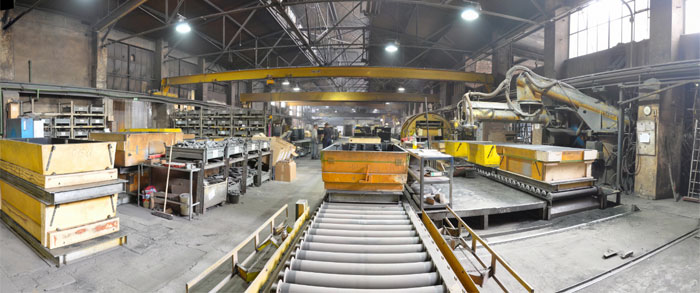Conveyors in Difficult Environments
How to protect conveyors in gritty, wet, chemical and other tough environments

Conveyors are essential for manufacturing operations, but in some areas where they are exposed to dust, airborne debris, moisture or chemicals, there may be issues with their mechanical components. These environmental factors impact performance, equipment lifespan, maintenance burdens and safety, but can be dealt with if the conveyor is properly designed, used and maintained. Let’s dive into these issues.
Conveyors in dusty, gritty environments
Production areas typically have some level of airborne debris. Paper mills, for instance, deal with a large volume of airborne pulp that can jam conveyor rollers or damage belts. Foundries may have sand or other grit in the air. Sawmills or furniture plants must deal with sawdust. Some conveyors cross between indoor buildings and are exposed to the air outside, where they can absorb dust. In some operations, paint over-spray can harm conveyors.
Clean your conveyors
Grit and dust destroy mechanical devices — conveyor included. It may take time, but it will happen. These materials wear down rollers, gears and pulleys, reducing their useful lifespan. You can greatly reduce these effects by cleaning your conveyors. Even in relatively “clean” warehousing operations, there can be enough airborne debris to make a conveyor cleaning program necessary.
Your cleaning program may be as easy as wiping down, vacuuming or blowing off your conveyors at shift changes, but may require even stronger measures in some applications. If you blow debris off your conveyors, make certain that the debris doesn’t harm other machinery in the area, since you are essentially kicking it back into the air.
Belt systems suffer from “carryback,” which means that the belts convey grit into the conveyor, damaging both the belt and components. Some have raised questions about the negative effects of cleaning on belts themselves. Cleaning the belt may wear it a little, but grit is far worse than any cleaning regimen.
Cleaning your belt always extends its life — a lack of cleaning damages the belt more than a proper cleaning regimen.
The frequency, technique and thoroughness of your cleaning regimen depends on the environment and type of conveyor. For very dusty areas, you may need to clean quite frequently to reduce the chances of a conveyor breakdown due to debris.

Design conveyors to resist dust and grit
Some very gritty areas may require special bearings or seals along with regular cleaning. Re-greasable bearings are often necessary. Conveyors can be manufactured to hold up under dusty or dirty conditions, but all the factors should be known in advance of specifying the conveyors.
Belt tracking & cleaning
When conveyor belts don’t track correctly, it’s usually either an issue with sprocket alignment or dust/debris build-up. The more dust in the air, the bigger the issue. You should be regularly cleaning your belts so that they last longer and don’t lose tracking or wear down other components over time. Mis-tracking can wear down belts and damage components, so the cleaning job is worth your time. The goal is to prevent operational downtime.
Separate your conveyors from airborne debris sources and moisture
It’s not always possible, but when it is, separating conveyors from environmental factors is always desirable. You can use economical means such as retractable curtain walls that protect the conveyors from grit-producing processes, chemicals or moisture. Even if the system is constructed to withstand the environment, protecting it helps increase its lifespan and reduce maintenance and cleaning burdens. Various curtain walls are available in food-grade wash down configurations to help in wet areas.
Heat is always a factor for mechanical devices, conveyors included. However, conveyors function well in hot environments if specified and maintained correctly. Read more about conveyors and heat.
Explosive conditions require specialized conveyor design
In operations like paint factories, chemical plants, munitions manufacturing and other heavy manufacturing, explosion-proof machinery is often required throughout the facility, including the conveyor system. When we work in these facilities, the top concern is to ensure the conveyors are safe to operate. Typically this means grounding the system, specifying appropriate belt materials for static conductivity, using explosion-proof motors and other safeguards to increase safety.
Of course, you must also make sure the conveyor can do the job it’s designed to do, and that it can weather any difficult environmental conditions.
Washdown and chemicals
Food production facilities can be difficult for conveyor systems, but there are conveyors designed specifically for wet environments that feature easy disassembly for cleaning, drains built into the frames and stainless steel components. These systems eliminate “pockets” where substances can stick or gather to become a contamination hazard.
There are many other types of conveyors for wet environments, including larger systems specifically constructed for wet conditions. You can specify plastic or other belts and stainless steel construction on many types of standard conveyor systems.
Final thoughts
Conveyors are resilient and functional in most environments, if designed, used and maintained correctly. Contact us for fast assistance on your project. Remember that proper specification, vigilant maintenance and systematic cleaning are your best ways to keep conveyors up, running and productive.
Tags: Manufacturing, ergonomics
Scott Stone is Cisco-Eagle's Vice President of Marketing with 35 years of experience in material handling, warehousing and industrial operations. His work is published in multiple industry journals an websites on a variety of warehousing topics. He writes about automation, warehousing, safety, manufacturing and other areas of concern for industrial operations and those who operate them.



